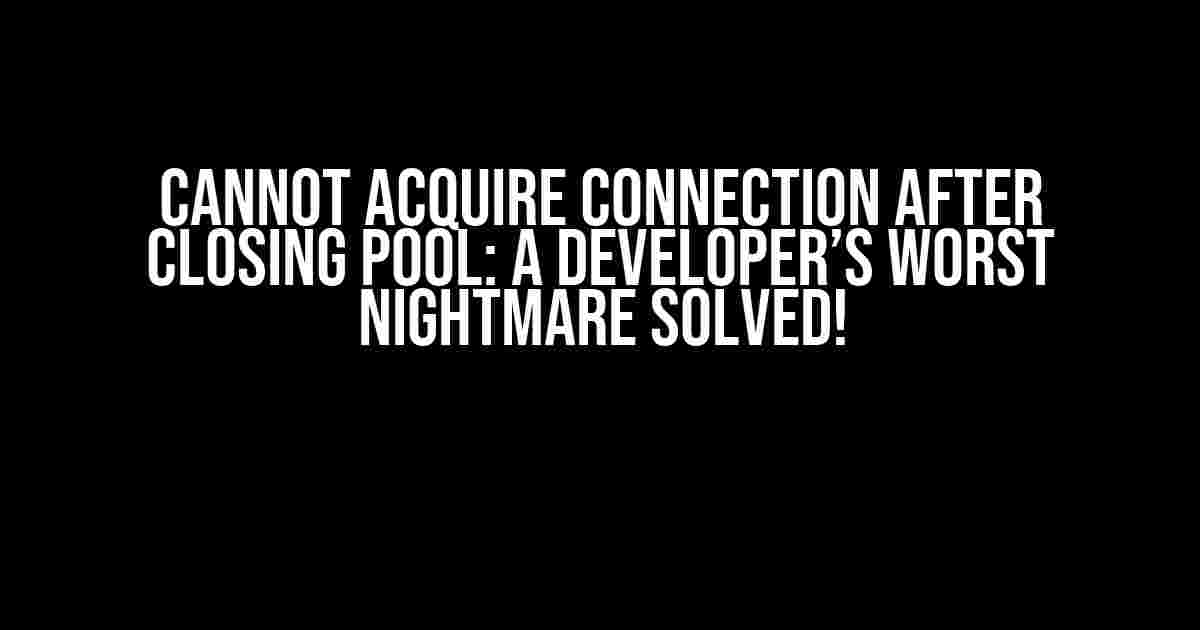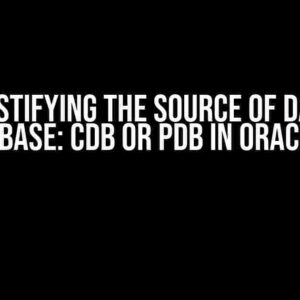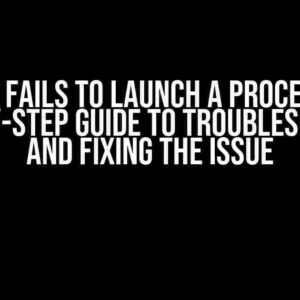Have you ever encountered the dreaded “Cannot acquire connection after closing pool” error? You’re not alone! This error can be frustrating, especially when you’re in the middle of a critical project. Fear not, dear developer, for we’ve got a comprehensive guide to help you tackle this issue and get back to coding in no time.
What’s Causing the Error?
The “Cannot acquire connection after closing pool” error typically occurs when you’re using a connection pool to manage your database connections. A connection pool is a mechanism that allows your application to reuse existing database connections instead of creating new ones every time it needs to access the database. While connection pooling is an excellent way to improve performance, it can sometimes lead to this error.
Why Does it Happen?
The error usually occurs when you close the connection pool prematurely, and then try to acquire a new connection from the same pool. This can happen due to various reasons, including:
- Incorrect configuration: Misconfigured connection pool settings can lead to this error.
- Connection leak: Unreleased connections can cause the pool to close, making it impossible to acquire new connections.
- Resource limitations: Running out of resources, such as memory or threads, can cause the pool to shut down.
- Database issues: Problems with the database, like network connectivity or authentication errors, can also trigger this error.
Solving the “Cannot Acquire Connection after Closing Pool” Error
Now that we’ve identified the possible causes, let’s dive into the solutions!
1. Review Your Connection Pool Configuration
Double-check your connection pool settings to ensure they’re correct and optimized for your application. Verify the following:
| Setting | Description |
|---|---|
| Pool Size | Ensure the pool size is sufficient for your application’s needs. |
| Idle Timeout | Adjust the idle timeout to prevent connections from being closed too quickly. |
| Connection Timeout | Verify the connection timeout is set to a reasonable value. |
2. Fix Connection Leaks
Connection leaks can cause the pool to close prematurely, so it’s essential to identify and fix them. Use tools like Java VisualVM or YourKit to detect and analyze connection leaks.
SELECT pg_stat_activity.query
FROM pg_stat_activity
WHERE query LIKE '% idle in transaction %';
This SQL query helps you identify idle transactions that might be causing connection leaks.
3. Optimize Resource Utilization
Ensure your application is optimized to use resources efficiently. Monitor memory and thread usage to avoid resource starvation.
top -H -p <PID>
This command helps you monitor thread usage for a given process ID (PID).
4. Verify Database Connectivity
Check your database connectivity to ensure it’s stable and functioning correctly. Verify:
- Network connectivity: Ensure your application can reach the database server.
- Authentication: Verify your database credentials are correct and up-to-date.
- Schema: Ensure the database schema is consistent with your application’s expectations.
Preventing the “Cannot Acquire Connection after Closing Pool” Error
Prevention is better than cure! To avoid this error, follow best practices when working with connection pools:
1. Use a Robust Connection Pooling Library
Choose a reliable connection pooling library, such as HikariCP, Apache DBCP, or C3P0, which provides features like connection leak detection and automatic reconnect.
2. Implement Connection Pool Monitoring
Monitor your connection pool’s health by tracking metrics like connection usage, idle connections, and wait times. This helps you identify potential issues before they escalate.
3. Avoid Premature Pool Closure
Avoid closing the connection pool unnecessarily, especially when your application is still using connections. Instead, use a lazy connection closure strategy to ensure connections are closed only when they’re no longer needed.
4. Practice Defensive Programming
Write defensive code that anticipates and handles potential errors, including connection pool closures. Use try-catch blocks and error handling mechanisms to ensure your application can recover from errors.
Conclusion
The “Cannot acquire connection after closing pool” error can be frustrating, but it’s not insurmountable. By understanding the causes, reviewing your connection pool configuration, fixing connection leaks, optimizing resource utilization, and verifying database connectivity, you can overcome this error and get back to developing your application.
Remember, prevention is key! Implementing robust connection pooling libraries, monitoring connection pool health, avoiding premature pool closure, and practicing defensive programming can help you avoid this error altogether.
Now, go forth and code with confidence!
Frequently Asked Question
Having trouble acquiring a connection after closing a pool? Worry not, we’ve got you covered! Here are some frequently asked questions to help you troubleshoot the issue.
What happens when I close a connection pool?
When you close a connection pool, all the existing connections in the pool are closed, and the pool is reset. This means that any subsequent requests for a connection will result in a new connection being created, rather than reusing an existing one.
Why can’t I acquire a connection after closing the pool?
There could be several reasons why you can’t acquire a connection after closing the pool. It’s possible that the pool is not properly configured, or that there’s a bug in your code that’s preventing the pool from being recreated. Check your configuration and code for any errors or issues.
How do I troubleshoot the issue of not being able to acquire a connection?
To troubleshoot the issue, start by checking the pool configuration and settings. Ensure that the pool is properly configured and that the connection properties are correct. Also, check the server logs for any errors or issues related to the connection pool. If you’re still having trouble, try enabling debugging or logging to get more insight into what’s happening.
What are some common mistakes to avoid when working with connection pools?
Some common mistakes to avoid when working with connection pools include not properly closing the connections, not configuring the pool correctly, and not handling errors properly. Additionally, make sure to test your connection pool configuration and code thoroughly to ensure it’s working as expected.
Can I reuse a connection pool after closing it?
Yes, you can reuse a connection pool after closing it. However, you’ll need to recreate the pool and reconfigure it correctly. Make sure to follow the correct steps to close and reopen the pool to avoid any issues.



